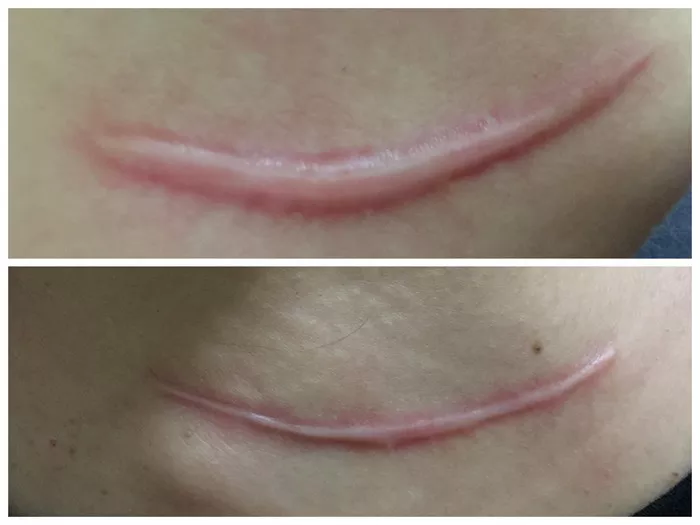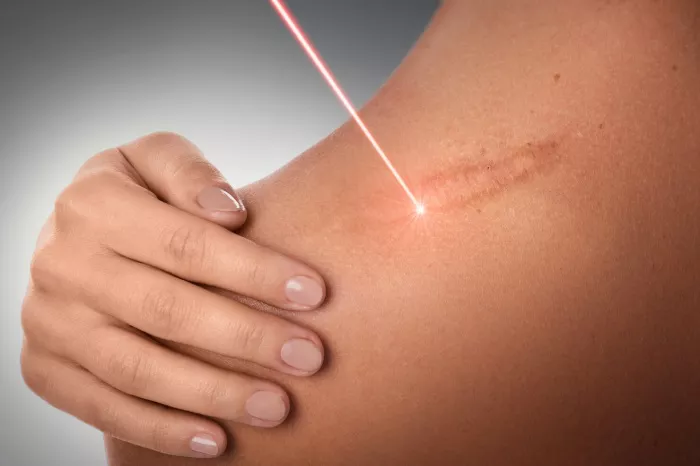The journey from injury to scar involves a series of complex biological processes orchestrated by the body. The four stages of wound healing—hemostasis, inflammation, proliferation, and remodeling—work in tandem to repair damaged tissue and restore skin integrity.
Hemostasis: This initial stage involves the formation of a blood clot to stop bleeding and create a temporary barrier over the wound.
Inflammation: Inflammation sets the stage for healing by mobilizing immune cells to the site of injury to fend off infection and clear away debris.
Proliferation: During this phase, new tissue is generated as fibroblasts produce collagen, the main structural protein in the skin, to rebuild the damaged area.
Remodeling: The final stage of wound healing involves the restructuring of collagen fibers to strengthen the scar tissue. However, this process may result in a scar that appears different from the surrounding skin.
Collagen Production and Scar Tissue: Balancing Act of Repair
Collagen plays a pivotal role in wound repair, providing structural support and stability to the healing tissue. However, an imbalance in collagen production can lead to the formation of abnormal scars, such as hypertrophic scars or keloids.
Excessive Collagen Deposition: In some cases, fibroblasts continue to produce collagen beyond what is necessary for wound repair, resulting in raised or thickened scars known as hypertrophic scars or keloids.
Disorganized Collagen Arrangement: Scar tissue may also exhibit an irregular arrangement of collagen fibers, contributing to its distinct appearance compared to normal skin.
Types of Scars: Navigating the Landscape of Scar Diversity
Scars come in various forms, each with its own characteristics and underlying causes. Understanding the different types of scars can shed light on why some scars remain permanent while others fade over time.
Keloids: Keloids are characterized by their tendency to extend beyond the boundaries of the original wound, often growing larger and more prominent over time. They result from an overproduction of collagen and are more common in individuals with darker skin tones.
Hypertrophic Scars: Unlike keloids, hypertrophic scars remain within the confines of the original wound but are raised and may be red or purple in color. They are caused by excessive collagen production during the healing process.
Atrophic Scars: Atrophic scars are characterized by their sunken or depressed appearance and are often the result of tissue loss, such as that caused by acne or chickenpox.
Contracture Scars: Contracture scars result from the tightening of skin tissue during wound healing, often occurring after burns or extensive tissue damage. These scars can limit mobility and may require surgical intervention to correct.
Factors Influencing Scar Permanence: Unlocking the Secrets of Scar Development
Several factors can influence the severity and permanence of scars, ranging from genetic predispositions to the characteristics of the wound itself.
Genetics: Genetic factors play a significant role in determining an individual’s propensity to develop certain types of scars, such as keloids.
Skin Type: Differences in skin pigmentation, thickness, and elasticity can influence how scars form and heal.
Wound Depth and Size: Deeper or larger wounds are more likely to result in noticeable scars, especially if the underlying tissue is extensively damaged.
Location: Scars that form over joints or areas of high tension may be more prone to distortion or contracture, affecting their appearance and functionality.
Scar Treatment Options: Bridging the Gap Between Science and Innovation
While scars may be permanent, various treatment options are available to improve their appearance and minimize their impact on daily life.
Medical Treatments: Dermatologists may recommend interventions such as corticosteroid injections, laser therapy, surgical excision, or the use of silicone sheets or gels to flatten and soften scars.
Home Remedies: While evidence for their efficacy is limited, home remedies like massage, onion extract, and essential oils may offer some benefit in reducing scar visibility and improving skin texture.
Scar Prevention: Nurturing Wounds to Minimize Scarring
Prevention is often the best strategy for minimizing scarring. Proper wound care can promote optimal healing and reduce the risk of excessive scar formation.
Keep the Wound Clean and Moist: Cleanse the wound gently with mild soap and water, and keep it moist with petroleum jelly or an antibiotic ointment to promote healing.
Protect from Sun Exposure: Shield the healing wound from direct sunlight to prevent hyperpigmentation and minimize the risk of developing dark or discolored scars.
Avoid Picking at Scabs: Resist the urge to pick at scabs or scratch the healing wound, as this can disrupt the healing process and increase the likelihood of scarring.
Managing Scar Appearance: Concealing Scars with Confidence
For individuals seeking to conceal scars for cosmetic reasons, makeup and camouflage techniques offer a non-invasive solution to improve confidence and self-esteem.
Camouflage Makeup: Specialized makeup products designed to conceal scars, such as color-correcting creams and long-wear foundations, can help minimize their appearance and blend them with the surrounding skin.
Scar Camouflage Techniques: Advanced makeup techniques, such as stippling, layering, and blending, can create realistic-looking skin textures and tones to camouflage scars effectively.
Emotional Impact of Scars: Recognizing the Psychological Toll
Scars not only affect physical appearance but can also have a profound emotional impact on individuals, leading to feelings of self-consciousness, embarrassment, or even depression.
Seeking Support: It’s essential for individuals struggling with the emotional effects of scarring to seek support from friends, family, or mental health professionals who can offer empathy, understanding, and guidance.
Coping Mechanisms: Engaging in activities that boost self-esteem and confidence, such as exercise, creative pursuits, or self-care rituals, can help individuals cope with the psychological effects of scarring and cultivate a positive self-image.
Consulting a Dermatologist: Expert Guidance for Scar Management
For personalized scar treatment and management options tailored to individual needs, consulting a dermatologist or skincare specialist is highly recommended.
Professional Evaluation: A dermatologist can assess the type, severity, and underlying causes of scars and recommend appropriate treatment modalities based on the individual’s unique circumstances.
Comprehensive Care Plan: Dermatologists offer a range of medical interventions, cosmetic procedures, and supportive therapies to address both the physical and emotional aspects of scarring, ensuring comprehensive care and optimal outcomes.
Conclusion: Navigating the Journey of Scar Permanence
Scars may be a permanent reminder of past injuries, but with the right approach, they need not define or diminish one’s quality of life. By understanding the biological processes underlying scar formation, exploring effective treatment options, and embracing self-care strategies, individuals can navigate the journey of scar permanence with confidence and resilience.
Whether seeking medical intervention to improve scar appearance or exploring cosmetic techniques to conceal scars, the path to scar management is as unique as the scars themselves. By empowering individuals with knowledge, support, and access to professional guidance, we can ensure that scars become not obstacles to overcome but reminders of the body’s remarkable capacity for healing and renewal.
[inline_related_posts title=”You Might Be Interested In” title_align=”left” style=”list” number=”6″ align=”none” ids=”6745,6742,6693″ by=”categories” orderby=”rand” order=”DESC” hide_thumb=”no” thumb_right=”no” views=”no” date=”yes” grid_columns=”2″ post_type=”” tax=””]

































